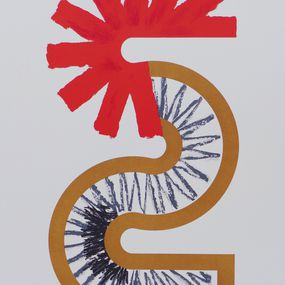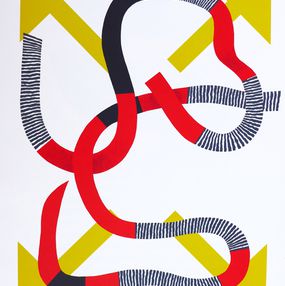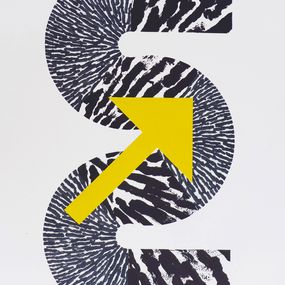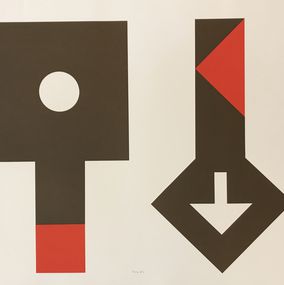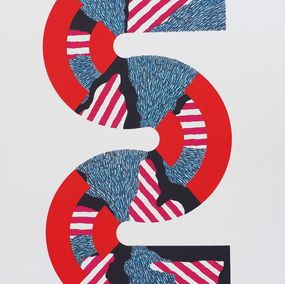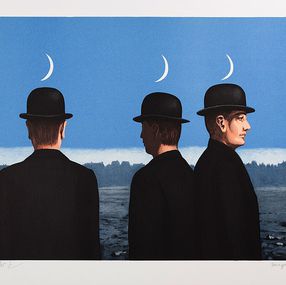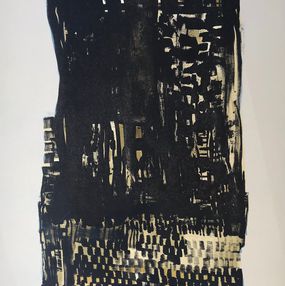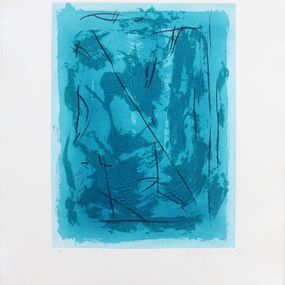
Ultimes 2,
1996
Kumi Sugaï
Print : lithography
76 x 56 x 0.1 cm 29.9 x 22 x 0 inch
Second NOT DISPLAYED BLUR TEXT
Free returns within 14 days
Authenticity guaranteed
Learn moreSecure payment
About the artwork
Type
Numbered and limited to 100 copies
1 copy available
Signature
Plate signed
Authenticity
Sold with certificate of Authenticity from the gallery
Invoice from the gallery
Medium
Dimensions cm • inch
76 x 56 x 0.1 cm 29.9 x 22 x 0 inch Height x Width x Depth
Support
Framing
Not framed
Artwork sold in perfect condition
Artwork location: France
Imagine it at home

Discover more by the artist
Presentation
In 1937, he dropped out to work as a designer at a railway company until the end of World War II. In 1952, Kumi Sugaï moved to Paris and absorbed western styles, including Abstract Expressionism, and later, Minimalism and Pop Art. At first, Sugai worked with traditional ukiyo-e woodblock techniques, using bright colors to create prints infused with contemporary western influences.
In the 1960s, however, Sugai transitioned into painting and printing more geometric images of letters and traffic and directional signs. He quickly met international success, and exhibited work at the Sao Paulo Biennale, documenta at Kassel, and the Venice Biennale, as well as solo shows in New York and Tokyo.
In addition to painting, Kumi Sugaï wrote essays on his artistic process and, inspired by his friend, Alberto Giacometti (Swiss, 1901–1966), translated the subject matter of some of his paintings into small sculptures. Though his work fell out of the public eye, Sugai continued to work in his geometric style for the rest of his life. Sugai died in his hometown of Kobe in 1996.
More works from Galerie Hus
Artsper delivers internationally. The list of countries is available in the first step of your cart.
If your country is not listed contact us at [email protected] and we will see what we can do.
Note that Customs fees may apply for works shipped internationally. This is indicated in the first step of the shopping cart.
You can choose a delivery address different from the billing address. Make sure that a trusted person is present to receive the work if you cannot be there.
Have you purchased a painting, sculpture or work on paper?
Find our expert advice for the conservation and promotion of your works in the articles below:
Artsper offers you access to more than 200,000 works of contemporary art from 2,000 partner galleries. Our team of experts carefully selects galleries to guarantee the quality and originality of the works.
You benefit from:
-
Works at gallery price
-
Return within 14 days, regardless of your location
-
Easy resale of the work purchased on Artsper
-
Personalized research tools (selection and tailor-made universe)
Our customer service is available for any assistance.
At Artsper, our mission is to allow you to collect works of art with complete peace of mind. Discover the protections we offer at every stage of your shopping experience.
Buy works from top galleries
We work in close collaboration with carefully selected art galleries. Each seller on Artsper is carefully examined and approved by our team, thus ensuring compliance with our code of ethics. You therefore have the assurance of purchasing authentic, high-quality works.
Total transparency: you know what you are buying
Before being posted online, all artwork on Artsper is reviewed and validated by our moderation team. You can browse with complete peace of mind, knowing that each piece meets our criteria of excellence.
Personalized support: our experts at your service
Our team of contemporary art experts is available by phone or email to answer all your questions. Whether you want advice on a work or a tailor-made selection to enrich your collection, we are here to support you.
Resell your works with ease
If you have purchased a work on Artsper and wish to resell it, we offer you a dedicated platform to relist it. To find out more, click here.
Make offers with Artsper: negotiate like in a gallery
You have the possibility to propose a price for certain works, just like in a gallery. This feature allows you to initiate discussions and potentially acquire your coins at advantageous prices.
Get help with your negotiations
Our team will negotiate for you and inform you as soon as the best offer is obtained. Do not hesitate to call on our expertise to ensure a transaction at the best price.
Order securely
Artsper satisfaction assurance
We want you to be completely satisfied with your purchase. If the work you receive is not to your liking, you have 14 days to return it free of charge, and you will be refunded in full, whatever the reason.
Secure payment with Artsper partners
All credit card payments are processed by Paybox, the world leader in payment solutions. Thanks to their strict security standards, you can transact with confidence.
Problem Support
In the rare event that an artwork arrives damaged or not as described, we are here to help. Whether for a return, refund, restoration or exchange, our team will support you throughout the process and will ensure that we find the solution best suited to your situation.
Conditions to benefit from Artsper protections:
-
Use one of the payment methods available on Artsper for your order.
-
Report any problems within one week of receiving the work.
-
Provide required photographic evidence (including original artwork and packaging).
Artsper guarantees cover the following cases:
-
The received work lacks a described characteristic (for example, a signature or frame).
-
The artwork has significant differences from its description (e.g. color variation).
-
The work is damaged upon receipt.
-
The work is lost or damaged by the carrier.
-
Delivery is significantly delayed.
With Artsper, you collect with complete peace of mind.







